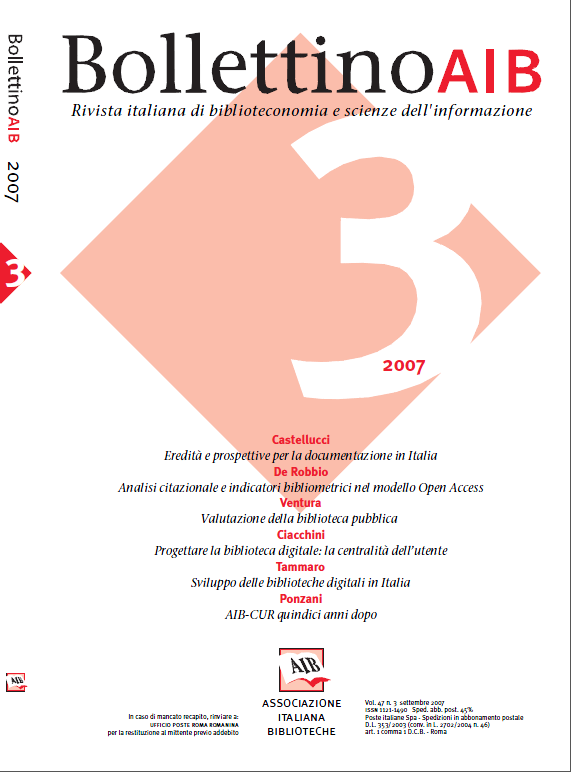Analisi citazionale e indicatori bibliometrici nel modello Open Access
Contenuto principale dell'articolo
Abstract
This article is focused on the bibliometric methods used for research evaluation, within the well known field of the bibliometrics which uses mathematical and statistical techniques to analyze the publications distribution patterns, and to explore their impact into the scholarly communities. While the bibliometric methods are used more often in the LIS, bibliometrics offers a wide range of applications in a variety of fields of knowledge. Since the research evaluation requires a double approach: quantitative (bibliometric analysis) and qualitative (peer-review, panel...), the fundamental idea is that the measurement of the scientific knowledge uses both the methods.
Though the IF or impact factor is the most well known bibliometric index, is not the only one suggested by ISI (now Thompson) to refer. In the Open Access world are spreading a wide number of initiatives and projects regarding the "bibliometrics" field, in which are being testing alternative solutions to the traditional IF, for example the Eigenfactor, the Hirsch index and its variations like the g-index, a-index, h-b-index, tools that mark a meaningful change in this fascinating field.
While the indicators "author-produced" are the citations, those "reader-produced" are usage data collected through webserver and linkresolver logs. A quantitative bibliometric indicator of new generation is the Usage Factor UF, complementary but non substitutive of traditional or alternative impact factor indicator. It will be necessary to organize the log data collection to share methods to obtain significant analysis. The article goes over some examples of new tools/projects for citational analysis in the Web area, among these the Web Impact Factor (WIF), and for the statistical analysis of logs and data, both bringing back to the new science known as metric of the web or Webometric.
Within the OAI framework there are many research projects of the webometric type, involving the intellectual output archivied into the repositories and their impact within the constitutive processes of the scholarly communication.
The theory assuming that an open access article in more likely to be read and therefore cited is matter of international debates and object of several studies, aimed to analyze the effects of the open access model and of the download on the citational impact. The article closes with a critical report on some of the most important works investigating the validity of this theory, from the original study of Lawrence, on Nature 2001, to the most recent works, the three postulates of Kurtz, the analysis run in 2006 by the Cornell's Library staff on the MathSciNet database, the study of Moed which imposed a completely new methodological level with the introduction of the "variable citation window".
Useful tools for the citational bibliometric analysis, on the statistical usage measurement of the researchs for the successful data monitoring, should be in the hands of the research producers, not in the hands of those commercial oligopoles that can influence the investment strategies and the national and international policies for the research.
Though the IF or impact factor is the most well known bibliometric index, is not the only one suggested by ISI (now Thompson) to refer. In the Open Access world are spreading a wide number of initiatives and projects regarding the "bibliometrics" field, in which are being testing alternative solutions to the traditional IF, for example the Eigenfactor, the Hirsch index and its variations like the g-index, a-index, h-b-index, tools that mark a meaningful change in this fascinating field.
While the indicators "author-produced" are the citations, those "reader-produced" are usage data collected through webserver and linkresolver logs. A quantitative bibliometric indicator of new generation is the Usage Factor UF, complementary but non substitutive of traditional or alternative impact factor indicator. It will be necessary to organize the log data collection to share methods to obtain significant analysis. The article goes over some examples of new tools/projects for citational analysis in the Web area, among these the Web Impact Factor (WIF), and for the statistical analysis of logs and data, both bringing back to the new science known as metric of the web or Webometric.
Within the OAI framework there are many research projects of the webometric type, involving the intellectual output archivied into the repositories and their impact within the constitutive processes of the scholarly communication.
The theory assuming that an open access article in more likely to be read and therefore cited is matter of international debates and object of several studies, aimed to analyze the effects of the open access model and of the download on the citational impact. The article closes with a critical report on some of the most important works investigating the validity of this theory, from the original study of Lawrence, on Nature 2001, to the most recent works, the three postulates of Kurtz, the analysis run in 2006 by the Cornell's Library staff on the MathSciNet database, the study of Moed which imposed a completely new methodological level with the introduction of the "variable citation window".
Useful tools for the citational bibliometric analysis, on the statistical usage measurement of the researchs for the successful data monitoring, should be in the hands of the research producers, not in the hands of those commercial oligopoles that can influence the investment strategies and the national and international policies for the research.
Dettagli dell'articolo
Fascicolo
Sezione
Articoli

Questo lavoro è fornito con la licenza Creative Commons Attribuzione - Condividi allo stesso modo 4.0.
